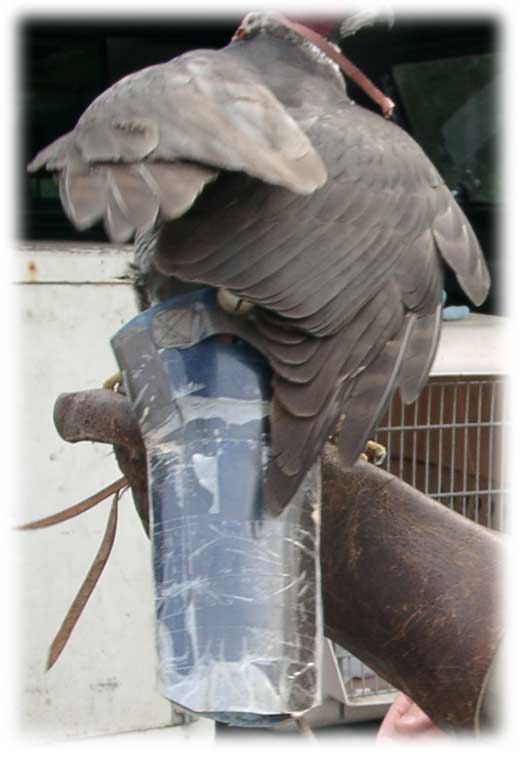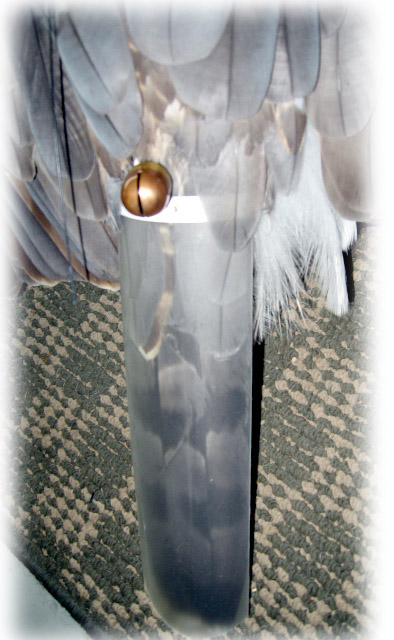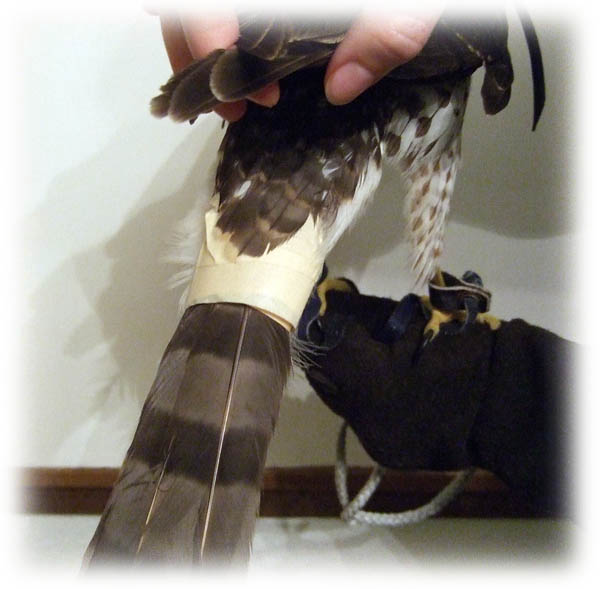A typical sheath for a Goshawk can be made of Mylar, vinyl plastic, TyVek, or x-ray film, although x-ray film may be too heavy depending on the bird. This is stiff enough to protect the feathers, sturdy enough to stand up to a Goshawk, but light weight enough not to bother the bird. For a bird like a Sharp-Shin, overhead projector plastic makes a good sleeve. Whatever material is chosen, it must not tear, splinter, warp, or shrink and must not react to water. The tailguard needs to be light weight so it does not pull the bird off balance or pull out a deck feather. It should also be light weight and low profile so the bird notices it as little as possible.
The top-facing panel is made with a hole that will slip over the bird's tail bell mount. The edges of the panels should be wrapped with electrical tape or another material that will prevent the edge of the sheath from cutting into the feathers. Some sheaths are made of two panels connected at the sides which will slid up the tail, others are constructed with one side attached to open and close around the tail attaching to itself with velcro. The sleeve must be long enough to cover the bottom tips of the feathers and prevent damage to them. Many falconers prefer to have this mounted across two deck feathers rather than one to reduce any chance of a deck feather getting pulled out.
The tail guard should be managed properly as with any other piece of equipment. Leaving it on too much will prevent a bird from preening, prevent her from spreading oil on her tail leading to even more brittle feathers, and will tend to hold in moisture potentially rotting the feathers or allowing mold to grow. Some falconers like to first scrub the inside surfaces of a potential tail guard with Simple Green or Odoban to remove any residue and deter spore growth, then dry the material completely before using as a tail guard. The guard is for short term use - for transportation or other handling that might lead to feather damage. Even wild birds damage feathers, so no feather damage can be completely prevented, but with those species who have more brittle feathers tools such as a tail guard can be very useful for their maintenance and management.
Frequently a freshly trapped bird will have the tail protected with gum paper packing tape (not regular tape as the adhesive will stick to the feathers). Gum paper packing tape requires you to cut a strip, wet it to get the adhesive activated, then apply it around the tail about halfway down. It will dry in place in a few minutes, and can be rinsed with a little warm water to release completely. Since a freshly trapped bird does not have bells or transmitters attached to the tail to allow a tail guard to be attached, this simple setup protects the tail temporarily. It can be left on for a few days to observe the bird, then washed off.
 |
A tail guard on a Goshawk. |
 |
A tail guard on a Goshawk. One advantage of this model is the ability to see the feathers through the cover.
Photo courtesy of Jo Turley |
 |
A temporary gumtape tail protector on a Cooper's Hawk. The masking tape was applied only over the gumtape to support it, it is not touching the feathers. Gumtape will then be wetted with warm water and will release from the tail completely. |